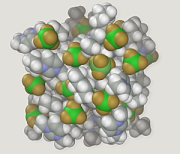
Molecular modeling on GPU is the technique of using a graphics processing unit (GPU) for molecular simulations.[1]
In 2007, NVIDIA introduced video cards that could be used not only to show graphics but also for scientific calculations. These cards include many arithmetic units (as of 2016[update], up to 3,584 in Tesla P100) working in parallel. Long before this event, the computational power of video cards was purely used to accelerate graphics calculations. What was new is that NVIDIA made it possible to develop parallel programs in a high-level application programming interface (API) named CUDA. This technology substantially simplified programming by enabling programs to be written in C/C++. More recently, OpenCL allows cross-platform GPU acceleration.
Quantum chemistry calculations[2][3][4][5][6][7] and molecular mechanics simulations[8][9][10] (molecular modeling in terms of classical mechanics) are among beneficial applications of this technology. The video cards can accelerate the calculations tens of times, so a PC with such a card has the power similar to that of a cluster of workstations based on common processors.
- ^ Stone JE, Phillips JC, Freddolino PL, Hardy DJ, Trabuco LG, Schulten K (December 2007). "Accelerating molecular modeling applications with graphics processors". Journal of Computational Chemistry. 28 (16): 2618–2640. CiteSeerX 10.1.1.466.3823. doi:10.1002/jcc.20829. PMID 17894371. S2CID 15313533.
- ^ Yasuda K (August 2008). "Accelerating Density Functional Calculations with Graphics Processing Unit". Journal of Chemical Theory and Computation. 4 (8): 1230–1236. doi:10.1021/ct8001046. PMID 26631699.
- ^ Yasuda K (February 2008). "Two-electron integral evaluation on the graphics processor unit". Journal of Computational Chemistry. 29 (3): 334–342. CiteSeerX 10.1.1.498.364. doi:10.1002/jcc.20779. PMID 17614340. S2CID 8078401.
- ^ Vogt L, Olivares-Amaya R, Kermes S, Shao Y, Amador-Bedolla C, Aspuru-Guzik A (March 2008). "Accelerating resolution-of-the-identity second-order Møller-Plesset quantum chemistry calculations with graphical processing units". The Journal of Physical Chemistry A. 112 (10): 2049–2057. Bibcode:2008JPCA..112.2049V. doi:10.1021/jp0776762. PMID 18229900. S2CID 4566211.
- ^ Ufimtsev IS, Martínez TJ (February 2008). "Quantum Chemistry on Graphical Processing Units. 1. Strategies for Two-Electron Integral Evaluation". Journal of Chemical Theory and Computation. 4 (2): 222–231. doi:10.1021/ct700268q. PMID 26620654.
- ^ Ivan S. Ufimtsev & Todd J. Martinez (2008). "Graphical Processing Units for Quantum Chemistry". Computing in Science & Engineering. 10 (6): 26–34. Bibcode:2008CSE....10f..26U. doi:10.1109/MCSE.2008.148. S2CID 10225262.
- ^ Tornai GJ, Ladjánszki I, Rák Á, Kis G, Cserey G (October 2019). "Calculation of Quantum Chemical Two-Electron Integrals by Applying Compiler Technology on GPU". Journal of Chemical Theory and Computation. 15 (10): 5319–5331. doi:10.1021/acs.jctc.9b00560. PMID 31503475. S2CID 202555796.
- ^ Joshua A. Anderson; Chris D. Lorenz; A. Travesset (2008). "General Purpose Molecular Dynamics Simulations Fully Implemented on Graphics Processing Units". Journal of Computational Physics. 227 (10): 5342–5359. Bibcode:2008JCoPh.227.5342A. CiteSeerX 10.1.1.552.2883. doi:10.1016/j.jcp.2008.01.047.
- ^ Christopher I. Rodrigues; David J. Hardy; John E. Stone; Klaus Schulten & Wen-Mei W. Hwu. (2008). "GPU acceleration of cutoff pair potentials for molecular modeling applications". In CF'08: Proceedings of the 2008 Conference on Computing Frontiers, New York, NY, USA: 273–282.
- ^ Peter H. Colberg; Felix Höfling (2011). "Highly accelerated simulations of glassy dynamics using GPUs: Caveats on limited floating-point precision". Comput. Phys. Commun. 182 (5): 1120–1129. arXiv:0912.3824. Bibcode:2011CoPhC.182.1120C. doi:10.1016/j.cpc.2011.01.009. S2CID 7173093.